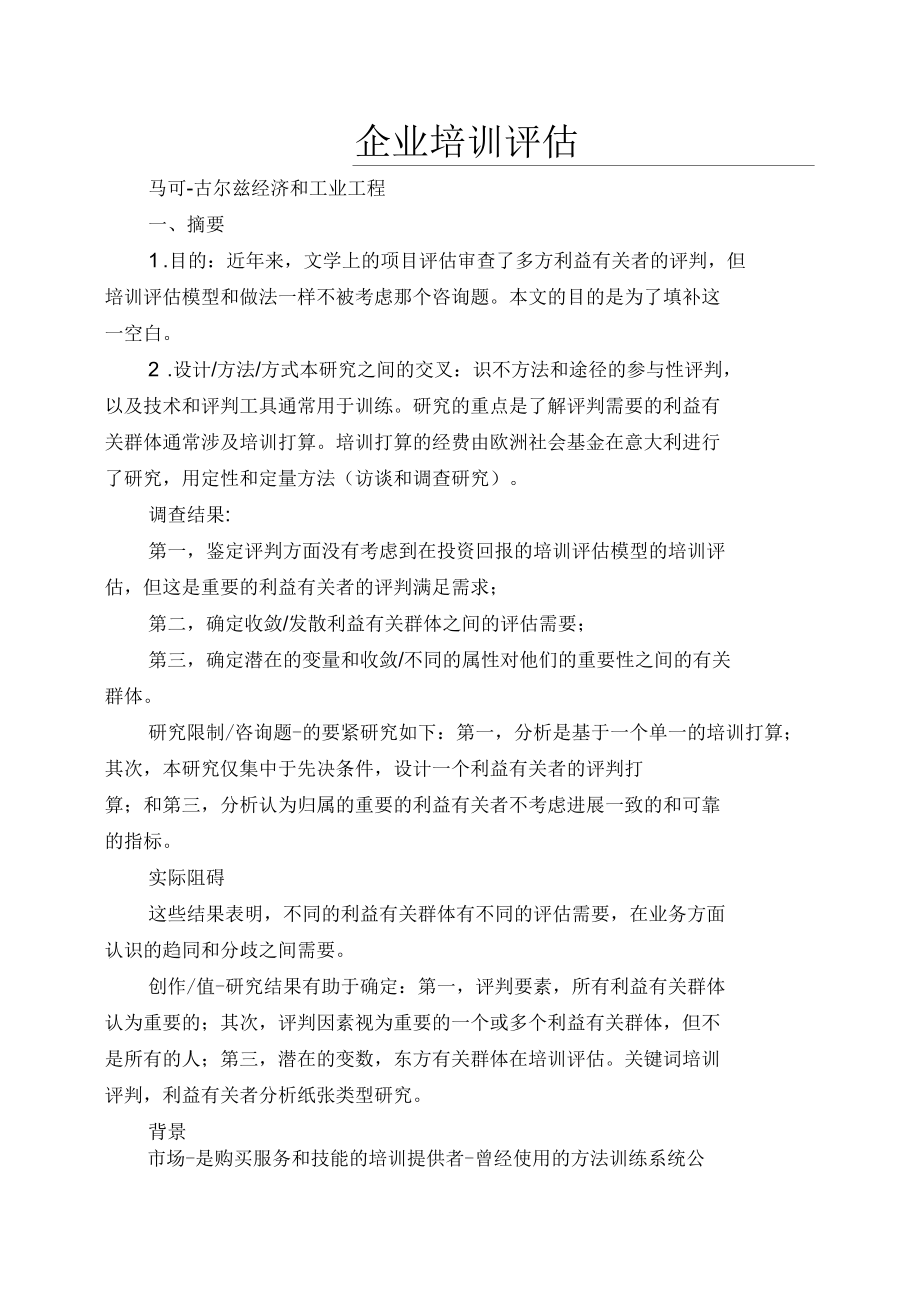 企业培训评估
企业培训评估



《企业培训评估》由会员分享,可在线阅读,更多相关《企业培训评估(10页珍藏版)》请在装配图网上搜索。
1、企业培训评估马可-古尔兹经济和工业工程一、摘要1 .目的:近年来,文学上的项目评估审查了多方利益有关者的评判,但培训评估模型和做法一样不被考虑那个咨询题。本文的目的是为了填补这一空白。2 .设计/方法/方式本研究之间的交叉:识不方法和途径的参与性评判,以及技术和评判工具通常用于训练。研究的重点是了解评判需要的利益有关群体通常涉及培训打算。培训打算的经费由欧洲社会基金在意大利进行了研究,用定性和定量方法(访谈和调查研究)。调查结果:第一,鉴定评判方面没有考虑到在投资回报的培训评估模型的培训评估,但这是重要的利益有关者的评判满足需求;第二,确定收敛/发散利益有关群体之间的评估需要;第三,确定潜在的
2、变量和收敛/不同的属性对他们的重要性之间的有关群体。研究限制/咨询题-的要紧研究如下:第一,分析是基于一个单一的培训打算;其次,本研究仅集中于先决条件,设计一个利益有关者的评判打算;和第三,分析认为归属的重要的利益有关者不考虑进展一致的和可靠的指标。实际阻碍这些结果表明,不同的利益有关群体有不同的评估需要,在业务方面认识的趋同和分歧之间需要。创作/值-研究结果有助于确定:第一,评判要素,所有利益有关群体认为重要的;其次,评判因素视为重要的一个或多个利益有关群体,但不是所有的人;第三,潜在的变数,东方有关群体在培训评估。关键词培训评判,利益有关者分析纸张类型研究。背景市场-是购买服务和技能的培训
3、提供者-曾经使用的方法训练系统公司建立关系的群体。作者感谢布瑞恩博士布洛赫为他的综合编辑的手稿境外公司。目前,然而,公司也尝试建立这种关系,通过参与公共项目通常受公共资助的机构,旨在鼓舞和促进连续的培训,这被认为是一个“集体利益”。在培训过程在这种情形下,许多演员需要作出的决定可能阻碍性能的培训倡议。通常,这些利益有关者有不同的机构任务,和训练的利益和目标可能是不同的:如将其列入评判过程中创建和爱护多样性的利益有关者参与集团(遗嘱,1993;马丢和格林尼,1997)。此外,“利益有关者能够关心专门大时,审查评估建议”修订方案。建议打算的人员普遍估量将在评估报告(布兰登,1999,363页)。这
4、项研究的重点是培训评估等多方利益有关者的情形下,和的目的是确定两国之间的交叉学科。第一是项目评估,正式的方法来研究的目标,过程,和阻碍的项目,政策和打算的实施在公共和私营部门。二是培训与进展治理,专门是,文学的评判模型和工具,用于评估培训公司。这项研究的重点是连续培训项目资金由意大利公共权力,以突出评判需要的利益有关群体通常涉及这类训练过程。研究报告在那个地点进行了接触后,利益有关者的规划和执行程序的培训模块,采纳定性和定量方法。专门是,研究过程包括最初的定性研究时期的关键线人,属于不同的利益群体,其次是定量研究整个人口。研究结果可用于有益的各种不同的用途。第一,本研究确定的趋同和分歧之间的评
5、判需要的不同利益有关群体。其次,它确定了“准则”东方的利益有关群体在培训评估。文献分析文献分析的重点是三个咨询题。第一,理论培训评判分析,讲明理论缘故利益有关者评判应用到培训能够被认为是重要的。结果在文学上的训练,然后提出利益有关者为基础的评判。最后一部分的调查关注的背景,公司培训系统运作,并表明实际意义的利益有关者培训评估。总的来讲,这部集锦知识差距和确定具体的研究咨询题。培训和教育是一项投资,该组织估量主动的回报;投资回报率(投资回报率)的培训和教育。为此,从层次评判模型柯克帕特里克(1998)和菲利普(1996)提出了投资回报率的培训评估模型,包括五个层次;每个调查不同层次:1 级。反应
6、:措施方案参与者的中意度。2 级。学习的重点是什么与会者学到在打算。3 级。应用和实施:决定是否参加申请什么他们学会工作。4 级。业务阻碍:侧重于实际取得的成果参加方案,他们成功地运用所学的。5 级。投资回报:比较货币利益的方案,该方案的成本。该模型已作出了宝贵奉献,培训评估的理论和实践,因为它强调必须考虑和评估培训在一个“视角”。然而,该模型至少有三个局限性。第一,该模型集中在限制设置的变量。事实上,这五个层次的评判,提出是基于一个专门简化的培训成效。专门是,他们没有考虑范畴广泛的组织,个人,网络的训练的设计和交付因素会阻碍培训成效(遗嘱,1993;布拉姆利和基特森,1994;卡侬-布鲁兹等
7、人。,1995;福特和卡瑞格,1995;萨拉斯和卡侬-布鲁兹,2001;坦南鲍姆和尤克尔,1992;)。二批判涉及因果之间的联系在不同层次的培训成果。是的,这是不可能实现的主动成果在高层次上,如果这种情形并没有显现在较低的水平以及。研究(艾利格和赞拿克,大宝,1989;1992;艾利格等人,1997)在该领域在专门大程度上未能证实这种因果联系。三分之一个弱点的层次模型的评判是,它缺乏一个多角色的视角。事实上,那个角度所承担的模型是该公司的股东。事实上,该模型假定每个水平的评判提供的数据,更翔实比去年(艾利格和赞拿克,1989)。那个假设产生了“知觉在培训评估,建立四级的结果将提供最有用的信息,
8、培训打算的有效性”(贝茨,2004,342页)。因此,评判需要利益有关者参与培训过程中被忽视,这是专门限制在背景的特点是存在一个多元化的演员。运用利益有关者评判培训可能是有益的处理这最后的批判,包括不同的观点的利益有关群体的评判程序的设计和实施(布拉姆利和基特森,1994;马丢和格林尼)。这也可能阻碍的批判,因为设计的评估程序的基础上的利益有关者的评判需要需要延伸设置的变量被认为是投资回报率的培训评估模型。利益有关者的评判是一种方法,确定是知情的特定的个人或团体。利益有关者是不同的群体感爱好的评估结果,要么因为他们是直截了当的阻碍(或参与)打算的活动,或是因为他们必须做出决定的程序或一个类似的
9、程序(米卡尔斯基和表亲,2000,213页)。文献中对利益有关者评判指出,评判是提升程序性能,它有一个工具的使用和结构必须作为一个系统,它支持的行动,和更是如此,决策过程(弗林,1992)。为此,有必要明白的评判需要的行动者参与该项目的评判系统在设计:工具使用,也许是最早使用类型的审查文学,是指利用评判结果为基础的行动。例子仪器使用包括排除程序证明是无效的,修改程序的评估基础上,针对一个程序的新观众,分配新的预算支出打算和改变结构的组织在一个程序的运行(约翰逊,1998,94页)。因此它是重要的利益有关者为基础的评估过程,涉及激活的演员。按照这一理论对参与性评判(堂兄弟和惠特莫尔,1998;米
10、卡尔斯基和表亲,2000),这种列入可有用,当其目的是提升程序的性能或改变,当它的目的是解放弱势群体社会/文化群体在该打算的目标是。这种分类是一致的更一样的理论,利益有关者的治理,这是利益有关者理论治理工具,基于的假设是,组织的建立与利益有关者的关系,基于信任与合作将有竞争优势与企业相比,没有如此的关系。竞争优势来源于如此一个事实关系基础上的相互信任与合作方便快捷协议,减少交易成本(弗里德曼和英里,2006);和道德规范的利益有关者理论认为,治理,规范的理论基础,包括“确定道德或哲学为经营准则,公司治理”为核心的利益有关者理论(杜纳尔迪和普莱斯顿,1995,P71)。基于这种考虑,各种研究讨论
11、的话题,利益有关者培训评估采纳的概念,实际参与评判,它本身是在更一样的理论,利益有关者的治理工具。因此,本研究定义了一个利益有关者作为一个学科能够阻碍性能的训练过程,因为她/他要求作出决定的过程中。它还认为,评判系统作为一个“工具”的利益有关者提供必要的信息来验证他们的决定要求作出。Trainingevaluation:ananalysisofthestakeholdersevaluationneedsAbstractPurposeInrecentyears,theliteratureonprogramevaluationhasexaminedmulti-stakeholderevaluati
12、on,buttrainingevaluationmodelsandpracticeshavenotgenerallytakenthisproblemintoaccount.Theaimofthispaperistofillthisgap.Design/methodology/approachThisstudyidentifiesintersectionsbetweenmethodologiesandapproachesofparticipatoryevaluation,andtechniquesandevaluationtoolstypicallyusedfortraining.Thestud
13、yfocusesonunderstandingtheevaluationneedsofthestakeholdergroupstypicallyinvolvedintrainingprograms.AtrainingprogramfinancedbytheEuropeanSocialFundinItalyisstudied,usingbothqualitativeandquantitativemethodologies(in-depthinterviewsandsurveyresearch).FindingsThefindingsareasfollows:first,identificatio
14、nofevaluationdimensionsnottakenintoaccountinthereturnoninvestmenttrainingevaluationmodeloftrainingevaluation,butwhichareimportantforsatisfyingstakeholdersevaluationneeds;second,identificationofconvergences/divergencesbetweenstakeholdergroupsevaluationneeds;andthird,identificationoflatentvariablesand
15、convergences/divergencesintheattributionofimportancetothemamongstakeholdersgroups.Researchlimitations/implicationsThemainlimitationsoftheresearcharethefollowing:first,theanalysiswasbasedonasingletrainingprogram;second,thestudyfocusedonlyonthepre-conditionsfordesigningastakeholder-basedevaluationplan
16、;third,theanalysisconsideredtheattributionofimportancebythestakeholderswithoutconsideringthedevelopmentofconsistentandreliableindicators.PracticalimplicationsTheseresultssuggestthatdifferentstakeholdergroupshavedifferentevaluationneedsand,inoperationaltermsareawareoftheconvergenceanddivergencebetwee
17、nthoseneeds.Originality/valueTheresultsoftheresearchareusefulinidentifying:first,theevaluationelementsthatallstakeholdergroupsconsiderimportant;second,evaluationelementsconsideredimportantbyoneormorestakeholdergroups,butnotbyallofthem;andthird,latentvariableswhichorientstakeholdersgroupsintrainingev
18、aluation.IntroductionThemarketthatis,buyingskillsandservicesfromtrainingproviders-wasoncetheapproachusedbycompanytrainingsystemstoestablishrelationshipswithgroups.TheauthorsaregratefultoDrBrianBlochforhiscomprehensiveeditingofthemanuscript.outsidethefirm.Presently,however,companiesalsotrytoestablish
19、suchrelationshipsthroughparticipationinpublicprogramstypicallyfinancedbypublicbodiesandintendedtoencourageandstimulatecontinuoustraining,whichisconsideredtobea“collectivegood”.Intrainingprocessesdeliveredinsuchcontexts,manyactorsarerequiredtomakedecisionswhichmayhaveanimpactontheperformanceofthetrai
20、ninginitiative.Typically,thesestakeholdershavedifferentinstitutionalmissions,andtheirtraininginterestsandobjectivesmaybedifferentaswell:theirinclusionintheevaluationprocesscreatesandmaintainsdiversitywithintheparticipatingstakeholdergroup(Wills,1993;MathieandGreene,1997).Furthermore,“stakeholderscan
21、beparticularlyhelpfulwhenreviewingevaluators”recommendationsforprogramrevisions.Recommendationstoprogrampersonnelarecommonlyexpectedinevaluationreports(Brandon,1999,p.363).Thisstudyfocusesontrainingevaluationinsuchmulti-stakeholdercontexts,andtheaimistoidentifyintersectionsbetweentwodifferentdiscipl
22、ines.Thefirstisprogramevaluation,aformalizedapproachtothestudyofthegoals,processes,andimpactsofprojects,policiesandprogramsimplementedinpublicandprivatesectors.Thesecondistraininganddevelopmentmanagement,andinparticular,theliteratureontheevaluationmodelsandtoolsusedtoevaluatetrainingwithincompanies.
23、ThisstudyfocusesonacontinuoustrainingprojectfinancedbyanItalianpublicauthority,inordertohighlighttheevaluationneedsofthestakeholdergroupstypicallyinvolvedinthiskindoftrainingprocess.Intheresearchreportedhere,stakeholderswerecontactedaftertheplanninganddeliveryoftheprogramstrainingmodules,usingqualit
24、ativeandquantitativemethods.Inparticular,theresearchprocessconsistedofaninitialqualitativeresearchphaseofkeyinformantsbelongingtothedifferentstakeholdergroups,followedbyquantitativeresearchontheentirepopulation.Theresultsoftheresearchcanbeappliedusefullytovariousdifferentpurposes.First,thestudyident
25、ifiesconvergencesanddivergencesbetweentheevaluationneedsofthedifferentstakeholdergroups.Second,itidentifiesthe“guidelines”whichorientstakeholdergroupsintrainingevaluation.LiteratureanalysisTheliteratureanalysisfocusesonthreeissues.First,thetheoryontrainingevaluationisanalyzed,indicatingthetheoretica
26、lreasonswhythestakeholder-basedevaluationappliedtotrainingcanbeconsideredimportant.Thefindingsintheliteratureontrainingstakeholder-basedevaluationarethenpresented.Thefinalpartofthesurveyconcernsthecontextsinwhichcompanytrainingsystemsoperate,anddemonstratesthepracticalimportanceofstakeholder-basedtr
27、ainingevaluation.Overall,thissectionhighlightsknowledgegapsanddefinesspecificresearchquestions.Trainingandeducationareaninvestmentfromwhichtheorganisationexpectsapositivereturn;thatis,areturnoninvestment(ROI)fromtrainingandeducation.Forthisreason,startingfromthehierarchicalevaluationmodelofKirkpatri
28、ck(1998)andPhillips(1996)proposesaROItrainingevaluationmodelwhichcomprisesfivelevels;eachinvestigatingdifferentelements:. Level1.Reactions:measuresprogrammeparticipantsatisfaction. Level2.Learning:focusesonwhatparticipantshavelearnedduringtheprogramme. Level3.Applicationandimplementation:determinesw
29、hetherparticipantsapplywhattheylearnedonthejob. Level4.Businessimpact:focusesontheactualresultsachievedbytheprogrammeparticipants,astheysuccessfullyapplywhattheyhavelearned. Level5.ROI:comparesthemonetarybenefitsfromtheprogrammewiththeprogrammescosts.Thismodelhasmadevaluablecontributionstotrainingev
30、aluationtheoryandpractice,becauseitstressestheimportanceofthinkingaboutandassessingtrainingwithina“businessperspective”.Nevertheless,themodelhasatleastthreelimitations.First,themodelconcentratesonarestrictedsetofvariables.Infact,thefivelevelsofevaluation,whichitproposesarebasedonanextremelysimplifie
31、dviewoftrainingeffectiveness.Inparticular,theydonotconsiderawiderangeoforganisational,individual,training-designanddeliveryfactorsthatmayinfluencetrainingeffectiveness(Wills,1993;BramleyandKitson,1994;Cannon-Bowers,1995;FordandKraiger,1995;SalasandCannon-Bowers,2001;TannenbaumandYukl,1992;Kontoghior
32、ghes,2001).Thesecondcriticismconcernsthecausallinkagesamongtrainingoutcomesatdifferentlevels.Thatis,itisnotpossibletoachievepositiveresultsattoplevels,ifthisdidnotoccuratthelowerlevelsaswell.Research(AlligerandJanak,1989;Talbot,1992;Alliger,1997)inthefieldhaslargelyfailedtoconfirmsuchcausallinkages.
33、Athirdweaknessofthehierarchicalmodelofevaluationisthatitlacksamulti-actorperspective.Infact,thepointofviewassumedbythemodelisthatofthecompanysshareholders.Indeed,themodelassumesthateachlevelofevaluationprovidesdatathatismoreinformativethanthelast(AlligerandJanak,1989).Thisassumptionhasgenerated“thep
34、erceptionamongtrainingevaluatorsthatestablishinglevelfourresultswillprovidethemostusefulinformationabouttrainingprogrameffectiveness”(Bates,2004,p.342).Asaconsequence,theevaluationneedsofthestakeholdersinvolvedinthetrainingprocessareneglected,andthisisparticularlyrestrictiveincontextscharacterizedby
35、thepresenceofapluralityofactors.Applyingstakeholder-basedevaluationtotrainingmaybeusefulindealingwiththisfinalcriticismbyincludingthedifferentpointsofviewofthestakeholdergroupsintheevaluationprogramsdesignandimplementation(BramleyandKitson,1994;MathieandGreene,1997;Marketal.,2000;Holte-McKenzieetal.
36、,2006).Thiscouldalsoimpactonthefirstcriticism,becausedesigningtheevaluationprogramonthebasisofstakeholderevaluationneedsentailsextendingthesetofvariablesconsideredbytheROItrainingevaluationmodel.Forsomeyears,theliteratureonprogramevaluationhasdealtwiththetopicofmulti-stakeholderevaluation(Gregory,20
37、00;Marketal.,2000),althoughreflectionontheissueandpracticalevaluationinthetrainingfieldhavebeenlessevident(Lewis,1996).Infact,thebest-knownmodeloftrainingevaluationisbasedalmostexclusivelyonmeasuringresultsfromtheperspectiveofonesingleactor.Thisactorcorrespondslargelytothecompanysshareholders,consid
38、eredasthesubjectsthatfundtrainingprograms.Thisinevitablyinducestheevaluationsystemtofocusontheimpact,infinancialoroperationalterms,oftrainingoncompanyperformance,withoutconsideringtheeffectsonotherstakeholders:Stakeholder-basedevaluationisanapproachthatidentifies,andisinformedby,particularindividual
39、sorgroups.Stakeholdersarethedistinctgroupsinterestedintheresultsofanevaluation,eitherbecausetheyaredirectlyaffectedby(orinvolvedin)programactivities,orbecausetheymustmakeadecisionabouttheprogramoraboutasimilarprogram(MichalskiandCousins,2000,p.213).Theliteratureonstakeholder-basedevaluationstatestha
40、tifevaluationistoimproveprogramperformance,ithasaninstrumentaluseandmustbestructuredasasystem,whichsupportsactions,andevenmoreso,decision-makingprocesses(Flynn,1992).Forthisreason,itisnecessarytoknowtheevaluationneedsoftheactorsinvolvedintheprogramwhoseevaluationsystemhastobedesigned:Instrumentaluse
41、,perhapstheearliesttypeofuseexaminedinliterature,referstousingevaluationfindingsasabasisforaction.Examplesofinstrumentaluseincludeeliminatingaprogramshowntobeineffective,modifyingaprogrambasedonanevaluation,targetingaprogramtonewaudiences,allocatingnewbudgetoutlayforaprogramandchangingthestructureof
42、theorganizationinwhichaprogramoperates(BurkeJohnson,1998,p.94).Basedonsuchconsiderations,variousstudieshavediscussedthetopicofstakeholder-basedtrainingevaluationbyadoptingtheconceptofpracticalparticipatoryevaluation,whichitselfisbasedonthemoregeneral,instrumentaltheoryofthestakeholdermanagement.Henc
43、e,thisresearchstranddefinesastakeholderasasubjectabletoinfluencetheperformanceofatrainingprocess,becauseshe/heisrequestedtomakedecisionsduringtheprocess.Italsoconceivestheevaluationsystemasan“instrument”forprovidingthestakeholderswiththeinformationnecessarytovalidatethedecisionstheyarerequestedtomake.
- 温馨提示:
1: 本站所有资源如无特殊说明,都需要本地电脑安装OFFICE2007和PDF阅读器。图纸软件为CAD,CAXA,PROE,UG,SolidWorks等.压缩文件请下载最新的WinRAR软件解压。
2: 本站的文档不包含任何第三方提供的附件图纸等,如果需要附件,请联系上传者。文件的所有权益归上传用户所有。
3.本站RAR压缩包中若带图纸,网页内容里面会有图纸预览,若没有图纸预览就没有图纸。
4. 未经权益所有人同意不得将文件中的内容挪作商业或盈利用途。
5. 装配图网仅提供信息存储空间,仅对用户上传内容的表现方式做保护处理,对用户上传分享的文档内容本身不做任何修改或编辑,并不能对任何下载内容负责。
6. 下载文件中如有侵权或不适当内容,请与我们联系,我们立即纠正。
7. 本站不保证下载资源的准确性、安全性和完整性, 同时也不承担用户因使用这些下载资源对自己和他人造成任何形式的伤害或损失。
最新文档
- 中移动绩效管理系统1课件
- 第五节维生素D缺乏性佝偻病ppt课件
- 登革热主题班会ppt课件
- 新生儿持续肺动脉高压诊治进展课件
- 新湘少版三年级英语上册Unit2goodmorning课件
- 新生儿呼吸窘迫综合症(Neonatal-Respiratory-Distress-Syndrome)课件
- 中移动滚动规划中关于流量经营的考虑课件
- 电气排故高级证ppt课件
- 新浙教版-九年级科学上-第一章复习课件
- 把握新高考的难得机遇做一位成功的高考考生ppt课件
- 新生儿缺氧缺血性脑病课件
- 中科院讲义-分布式操作系统-Peterson和Dekker算法证明教学课件
- 新生儿巨细胞病毒感染课件
- 大学生恋爱观及恋爱问题的应对策略ppt课件
- 新生儿惊厥ppt课件
